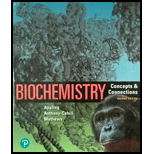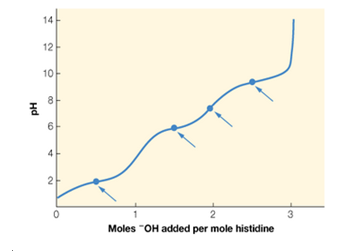
Pearson eText for Biochemistry: Concepts and Connections -- Instant Access (Pearson+)
2nd Edition
ISBN: 9780137533114
Author: Dean Appling, Spencer Anthony-Cahill
Publisher: PEARSON+
expand_more
expand_more
format_list_bulleted
Concept explainers
Textbook Question
Chapter 2, Problem 18P
Histidine is an amino acid with three titratable groups: an -NH3+ group (pKa = 9.2) —COOH group (pKa = 1.8). and an imidazole (
a. Identify which point on the titration curve corresponds to the pKa for each of the titratable groups, and which point corresponds to the pl. Explain your choices.
b. Calculate the value of pl for histidine.

Expert Solution & Answer
Want to see the full answer?
Check out a sample textbook solution
Students have asked these similar questions
See question below...please show steps
Please see image
How are drugs absorbed through inhalation? Please give the key pharmacokinetic ideas of pulmonary absorption including references to lipid solubility.
Chapter 2 Solutions
Pearson eText for Biochemistry: Concepts and Connections -- Instant Access (Pearson+)
Ch. 2 - Suppose a chloride ion and a sodium ion are...Ch. 2 - Draw two different possible hydrogen-bonding...Ch. 2 - Prob. 3PCh. 2 - 4. What is the pH of each of the following...Ch. 2 - Prob. 5PCh. 2 - The weak acid HA is 2% ionized (dissociated) in a...Ch. 2 - 7. Calculate the pH values and draw the titration...Ch. 2 - What is the pH of the following buffer mixtures?...Ch. 2 - a. Suppose you wanted to make a buffer of exactly...Ch. 2 - Prob. 10P
Ch. 2 - You need to make a buffer whose pH is 7.0, and you...Ch. 2 - Describe the preparation of 2.00 L of 100 glycine...Ch. 2 - Carbon dioxide is dissolved in blood (pH 7.4) to...Ch. 2 - What is the molecular basis for the observation...Ch. 2 - The anno acid arginine ionizes according to the...Ch. 2 - It is possible to make a buffer that functions...Ch. 2 - A student is carrying out a biological preparation...Ch. 2 - Histidine is an amino acid with three titratable...Ch. 2 - Prob. 19PCh. 2 - A biochemical reaction takes place in a 1.00 ml...Ch. 2 - Is RNA-binding enzyme RNase A more likely to have...Ch. 2 - Consider a protein in which a negatively charged...Ch. 2 - Prob. 23PCh. 2 - Prob. 24P
Knowledge Booster
Learn more about
Need a deep-dive on the concept behind this application? Look no further. Learn more about this topic, biochemistry and related others by exploring similar questions and additional content below.Similar questions
- The carbon-nitrogen peptide bond is rigid, but rotation can take place about the bond between the nitrogen and a-carbon atoms and the bond between the a-carbon and the carbonyl carbon atom. These bond angles define the conformation of the peptide chain. Consider the Ramachandran plot shown to answer both questions. fr (degrees) 180 120 8280 60 ° -60 Which observation most likely describes part of an observed a helix? p=-59 degrees; y = +150 degrees; many Ser residues qp=-140 degrees; w +130 degrees; many Val residues qp=-57 degrees; y = -47 degrees; many Pro residues qp=-60 degrees; y = -47 degrees; many Ala residues p = +60 degrees; y = +40 degrees; many Gly residues Which observations would not likely occur in a ẞ sheet? qp=-59 degrees; y = -49 degrees; many Ala residues qp = +60 degrees; w = +60 degrees; many Gly residues qp=-120 degrees; y = +120 degrees; many Tyr residues ☐ ☐ qp=-139 degrees; y = +135 degrees; many Val residues op=-51 degrees; w+153 degrees; many Gly and Pro…arrow_forwardPlease give an intuitive explanation of the difference, if any, between toxicokinetics and pharmacokinetics.arrow_forwardA protein biochemist attempted to determine the amino acid sequence of a decapeptide. The results from the trypsin, chymotrypsin, and cyanogen bromide treatments are shown: ⚫ Trypsin digestion gave two fragments with multiple residues (not in order): • T1: Ala, Arg, Phe, Gly, Thr, Trp, Tyr o T2: Lys, Met, Val Chymotrypsin digestion gave four fragments with multiple residues (not in order): • CT1: Ala, Phe • CT2: Thr, Trp • CT3: Lys, Met, Tyr, Val 。 CT4: Arg, Gly ⚫ Treatment with cyanogen bromide yielded a single amino acid, methionine, and a nonapeptide. What is a possible sequence of the decapeptide? Use three-letter abbreviations in your answer, and add a dash between each residue.arrow_forward
- A protein biochemist attempted to determine the amino acid sequence of a decapeptide. The results from the trypsin, chymotrypsin, and cyanogen bromide treatments are shown: • Trypsin digestion gave two fragments with multiple residues (not in order): T1: Ala, Arg, Phe, Gly, Thr, Trp, Tyr • T2: Lys, Met, Val Chymotrypsin digestion gave four fragments with multiple residues (not in order): • CTI: Ala, Phe 。 CT2: Thr, Trp • CT3: Lys, Met, Tyr, Val 。 CT4: Arg, Gly ⚫ Treatment with cyanogen bromide yielded a single amino acid, methionine, and a nonapeptide. What is a possible sequence of the decapeptide? Use three-letter abbreviations in your answer, and add a dash between each residue.arrow_forwardPoly-L-leucine in an organic solvent such as dioxane is a helical, whereas poly-L-isoleucine is not. Why do these amino acids with the same number and kinds of atoms have different helix-forming tendencies? L-isoleucine's methyl group sterically interferes with α-helix formation, whereas L-leucine's methyl group does not interfere. L-isoleucine lacks an NH group that can donate a hydrogen bond to stabilize an a helix, whereas L-leucine has an NH group. L-isoleucine contains a hydrogen-bond acceptor in close proximity to the main chain, whereas L-leucine lacks this group. L-isoleucine's ring structure prevents it from assuming the op value to fit into an a helix, whereas L-isoleucine does not have a ring structure.arrow_forwardSamples of the octapeptide AVGWRVKS are subjected to proteolytic cleavage by either trypsin or chymotrypsin. Select the most appropriate technique for separating the digestion products of AVGWRVKS if cleaved by trypsin. salting out ion-exchange chromatography gel-filtration chromatography dialysis Select the most appropriate technique for separating the digestion products of AVGWRVKS if cleaved by chymotrypsin. ion-exchange chromatography gel-filtration chromatography dialysis salting outarrow_forward
- Classify each description as corresponding to DNA or RNA. DNA a single molecule that can be over 10,000,000 nucleotides long Answer Bank usually single stranded RNA makes up the genome for eukaryotic organisms a single molecule that can form a complex secondary structure usually double stranded can be translated into a protein includes deoxyribose sugar includes the base uracilarrow_forwardA protein biochemist attempted to determine the amino acid sequence of a decapeptide. The results from the trypsin, chymotrypsin, and cyanogen bromide treatments are shown: • Trypsin digestion gave two fragments with multiple residues (not in order): T1: Ala, Arg, Phe, Gly, Thr, Trp, Tyr • T2: Lys, Met, Val ⚫ Chymotrypsin digestion gave four fragments with multiple residues (not in order): • CT1: Ala, Phe ° • CT2: Thr, Trp 。 CT3: Lys, Met, Tyr, Val • CT4: Arg, Gly ⚫ Treatment with cyanogen bromide yielded a single amino acid, methionine, and a nonapeptide. What is a possible sequence of the decapeptide? Use three-letter abbreviations in your answer, and add a dash between each residue. sequence:arrow_forwardClassify each nucleotide or nucleoside by the type of base and sugar present in each image. HO. -CH₂ 0 NH₂ OH OH OH он NH Classify the molecule. Opurine, deoxyribose purine, ribose Opyrimidine, deoxyribose pyrimidine, ribose NH₂ Classify the molecule. purine, deoxyribose Opyrimidine, ribose Opurine, ribose pyrimidine, deoxyribose H₂C. ·CH₂ NH Classify the molecule. pyrimidine, ribose Opurine, deoxyribose O purine, ribose Opyrimidine, deoxyribose OHarrow_forward
- Write the complementary sequence for GACATC. Write the new sequence in the standard 5'-to-3' notation. 5'- -3'arrow_forwardSuppose that you are given a mixture of proteins, whose properties are provided in the table. Isoelectric point (pl) Molecular weight (in kDa) Protein A 4.1 80 Protein B 9.0 81 Protein C 8.8 37 Protein D 3.9 172 Select one combination of techniques that can be used to isolate Protein B from Proteins A, C, and D. gel filtration chromatography and ultracentrifugation dialysis and ultracentrifugation dialysis and ion exchange chromatography ion exchange chromatography and gel filtration chromatographyarrow_forwardIn their famous experiment, Matthew Meselson and Franklin Stahl grew E. coli cells in a medium containing only the "heavy" isotope of nitrogen, 15N. These cells were then transferred to a medium with the "light" isotope of nitrogen, 14N. The results of the experiment supported the hypothesis of semiconservative replication, which was proposed by Watson and Crick. Heavy DNA (15N DNA), hybrid DNA, and light DNA (14N DNA) can be separated by centrifugation. If cells containing 15N DNA are transferred to a medium with only 14NH4Cl as a nitrogen source, what percentage of daughter molecules are composed of hybrid DNA after 3 generations? daughter molecules composed of hybrid DNA: Predict what percentage of daughter molecules would be composed of hybrid DNA if DNA exhibited conservative replication (i.e., if a daughter DNA molecule were composed of only newly synthesized DNA). daughter molecules composed of hybrid DNA: % %arrow_forward
arrow_back_ios
SEE MORE QUESTIONS
arrow_forward_ios
Recommended textbooks for you
 Human Heredity: Principles and Issues (MindTap Co...BiologyISBN:9781305251052Author:Michael CummingsPublisher:Cengage Learning
Human Heredity: Principles and Issues (MindTap Co...BiologyISBN:9781305251052Author:Michael CummingsPublisher:Cengage Learning Anatomy & PhysiologyBiologyISBN:9781938168130Author:Kelly A. Young, James A. Wise, Peter DeSaix, Dean H. Kruse, Brandon Poe, Eddie Johnson, Jody E. Johnson, Oksana Korol, J. Gordon Betts, Mark WomblePublisher:OpenStax College
Anatomy & PhysiologyBiologyISBN:9781938168130Author:Kelly A. Young, James A. Wise, Peter DeSaix, Dean H. Kruse, Brandon Poe, Eddie Johnson, Jody E. Johnson, Oksana Korol, J. Gordon Betts, Mark WomblePublisher:OpenStax College Principles Of Radiographic Imaging: An Art And A ...Health & NutritionISBN:9781337711067Author:Richard R. Carlton, Arlene M. Adler, Vesna BalacPublisher:Cengage Learning
Principles Of Radiographic Imaging: An Art And A ...Health & NutritionISBN:9781337711067Author:Richard R. Carlton, Arlene M. Adler, Vesna BalacPublisher:Cengage Learning Biology 2eBiologyISBN:9781947172517Author:Matthew Douglas, Jung Choi, Mary Ann ClarkPublisher:OpenStax
Biology 2eBiologyISBN:9781947172517Author:Matthew Douglas, Jung Choi, Mary Ann ClarkPublisher:OpenStax Biology (MindTap Course List)BiologyISBN:9781337392938Author:Eldra Solomon, Charles Martin, Diana W. Martin, Linda R. BergPublisher:Cengage Learning
Biology (MindTap Course List)BiologyISBN:9781337392938Author:Eldra Solomon, Charles Martin, Diana W. Martin, Linda R. BergPublisher:Cengage Learning

Human Heredity: Principles and Issues (MindTap Co...
Biology
ISBN:9781305251052
Author:Michael Cummings
Publisher:Cengage Learning

Anatomy & Physiology
Biology
ISBN:9781938168130
Author:Kelly A. Young, James A. Wise, Peter DeSaix, Dean H. Kruse, Brandon Poe, Eddie Johnson, Jody E. Johnson, Oksana Korol, J. Gordon Betts, Mark Womble
Publisher:OpenStax College

Principles Of Radiographic Imaging: An Art And A ...
Health & Nutrition
ISBN:9781337711067
Author:Richard R. Carlton, Arlene M. Adler, Vesna Balac
Publisher:Cengage Learning

Biology 2e
Biology
ISBN:9781947172517
Author:Matthew Douglas, Jung Choi, Mary Ann Clark
Publisher:OpenStax

Biology (MindTap Course List)
Biology
ISBN:9781337392938
Author:Eldra Solomon, Charles Martin, Diana W. Martin, Linda R. Berg
Publisher:Cengage Learning

Biomolecules - Protein - Amino acids; Author: Tutorials Point (India) Ltd.;https://www.youtube.com/watch?v=ySNVPDHJ0ek;License: Standard YouTube License, CC-BY